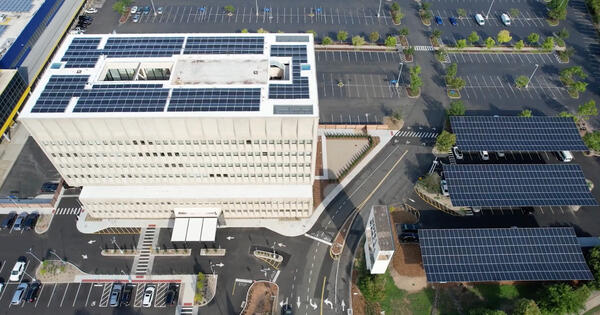To Make Greener Buildings, Try Innovating around the Edges
To Make Greener Buildings, Try Innovating around the Edges Yale Insights


“Opportunities for Green Property Retrofitting in a Post-COVID World”

Introduction
In a recent real estate colloquium at Yale SOM, experts discussed the importance of sustainable development goals (SDGs) in the building sector. Jessica Bailey, CEO of Nuveen Green Capital, highlighted the significance of buildings in addressing climate change and emphasized the need for a financing mechanism called C-PACE (Commercial Property-Assessed Clean Energy) to fund clean energy and efficiency projects. The colloquium also featured Brian Murray, CEO of Shift Capital, and developer Bruce Becker, who shared their experiences and insights on green property retrofitting.
The Climate Impact of Buildings
The International Energy Agency reported that building operations accounted for 26% of global energy system emissions in 2022. To achieve the 2030 net zero emissions targets, a 10% year-on-year reduction in carbon emissions from the building sector is required. This presents a significant challenge that needs to be addressed.
A Case Study: Hotel Marcel
Professor Cameron LaPoint presented a case study on the Hotel Marcel in New Haven, developed by Bruce Becker. The hotel underwent a deep retrofit, transforming it into an all-electric property with the capacity to operate off the grid using solar panels and battery storage. Becker aims to obtain certification for Hotel Marcel as the nation’s first Net Zero hotel.
As long as you’re looking at things as a zero sum you overlook opportunities. Sometimes, if you do more it costs less.
The Economic Case for Retrofitting
Bruce Becker emphasized the economic benefits of retrofitting buildings. He predicted that future generations would question the high-carbon-intensity choice of constructing new buildings instead of retrofitting existing ones. Despite initial challenges, he believes that retrofitting is more economical and less expensive, especially when considering federal and state incentives for green retrofits.
The Slow Progress of the Building Industry
The building industry has been slow to change and has even experienced a decline in productivity. Construction workers in 2020 were less productive than their counterparts in 1950, while worker productivity in manufacturing increased ninefold during the same period. The post-COVID economy has further complicated matters, with office buildings struggling to find tenants and lenders becoming risk-averse.
An Innovative Approach to Sustainability
Shift Capital, led by Brian Murray, takes an innovative approach to sustainability by investing in urban neighborhoods on public transportation. Their focus is on creating equitable neighborhoods in underserved areas through retrofit strategies. Murray highlighted the importance of experiments and unusual approaches in achieving sustainability goals.
The Role of C-PACE Loans
C-PACE loans, a financing tool developed by Jessica Bailey, are now available in over 30 states. These loans, which are repaid through tax assessments, offer better interest rates and longer terms than other forms of financing. Bailey emphasized that C-PACE is a public policy that recognizes energy upgrades as a public benefit, making it easier for building owners to implement sustainable projects.
Overcoming Challenges and Creating Impact
The panelists acknowledged the challenges they face in creating change and shifting the industry towards sustainability. Despite the frustrations and incremental progress, they remain committed to their goals. Bruce Becker emphasized the need for a cross-disciplinary approach and proactive search for innovative green solutions. Brian Murray highlighted the importance of learning from Europe’s cutting-edge ideas and technologies, while Jessica Bailey expressed her satisfaction in transitioning the way clean energy is financed and buildings are constructed.
SDGs, Targets, and Indicators
-
SDGs Addressed or Connected to the Issues Highlighted in the Article
- SDG 7: Affordable and Clean Energy
- SDG 9: Industry, Innovation, and Infrastructure
- SDG 11: Sustainable Cities and Communities
- SDG 13: Climate Action
The issues highlighted in the article are connected to these SDGs because they focus on reducing carbon emissions from buildings, promoting energy efficiency and clean energy, retrofitting existing buildings, and creating sustainable and resilient cities.
-
Specific Targets Under the Identified SDGs
- Target 7.2: Increase substantially the share of renewable energy in the global energy mix
- Target 9.4: Upgrade infrastructure and retrofit industries to make them sustainable, with increased resource-use efficiency and greater adoption of clean and environmentally sound technologies and industrial processes
- Target 11.6: Reduce the adverse per capita environmental impact of cities, including by paying special attention to air quality and municipal and other waste management
- Target 13.2: Integrate climate change measures into national policies, strategies, and planning
The article discusses the need to increase the share of renewable energy, retrofit buildings to make them sustainable, reduce carbon emissions from buildings, and integrate climate change measures into policies and planning.
-
Indicators Mentioned or Implied in the Article
- Carbon emissions in the building sector
- Energy use of buildings
- Productivity of the construction industry
- Availability and adoption of C-PACE loans
- Investment in urban neighborhoods on public transportation
The article mentions or implies these indicators as measures of progress towards the identified targets. They can be used to assess the reduction of carbon emissions, energy efficiency improvements, productivity growth, availability of financing options, and investment in sustainable urban development.
Table: SDGs, Targets, and Indicators
| SDGs | Targets | Indicators |
|---|---|---|
| SDG 7: Affordable and Clean Energy | Target 7.2: Increase substantially the share of renewable energy in the global energy mix | Carbon emissions in the building sector |
| SDG 9: Industry, Innovation, and Infrastructure | Target 9.4: Upgrade infrastructure and retrofit industries to make them sustainable, with increased resource-use efficiency and greater adoption of clean and environmentally sound technologies and industrial processes | Energy use of buildings |
| Target 9.4: Upgrade infrastructure and retrofit industries to make them sustainable, with increased resource-use efficiency and greater adoption of clean and environmentally sound technologies and industrial processes | Productivity of the construction industry | |
| SDG 11: Sustainable Cities and Communities | Target 11.6: Reduce the adverse per capita environmental impact of cities, including by paying special attention to air quality and municipal and other waste management | Carbon emissions in the building sector |
| SDG 13: Climate Action | Target 13.2: Integrate climate change measures into national policies, strategies, and planning | Availability and adoption of C-PACE loans |
| SDG 13: Climate Action | Target 13.2: Integrate climate change measures into national policies, strategies, and planning | Investment in urban neighborhoods on public transportation |
Behold! This splendid article springs forth from the wellspring of knowledge, shaped by a wondrous proprietary AI technology that delved into a vast ocean of data, illuminating the path towards the Sustainable Development Goals. Remember that all rights are reserved by SDG Investors LLC, empowering us to champion progress together.
Source: insights.som.yale.edu

Join us, as fellow seekers of change, on a transformative journey at https://sdgtalks.ai/welcome, where you can become a member and actively contribute to shaping a brighter future.







